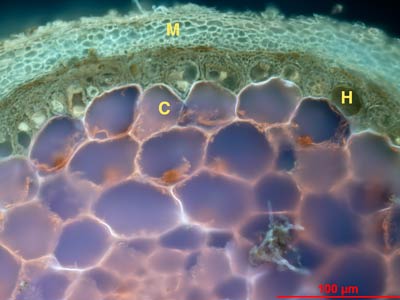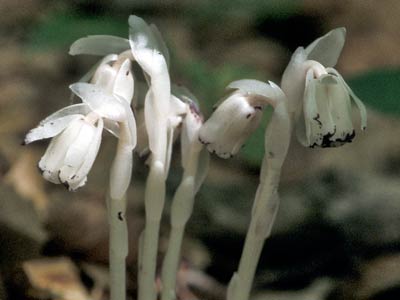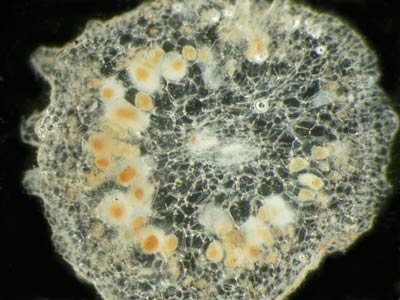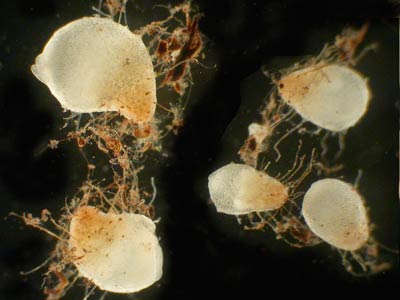MYCORRHIZAL ASSOCIATIONS: The Web Resource
Section 1. INTRODUCTION TO MYCORRHIZAS
A. Sponsors
| Web Hosting: Digital Pacific |
B. Introduction
This site was developed as an online textbook to provide current information about mycorrhizal associations. Information about this site, instructions, acknowledgements and site history information is provided in Section 13.
All images on this site are protected by copyright and were taken by the author unless another photographer is named.
Your browser must allow interactive content for animations and detailed images provided as roll-overs to be visible (hover mouse over images for interaction)
Major Data Sources
| Topic | Major Sources |
| Definition and classification of mycorrhizal associations | Brundrett 2004 |
| More information about mycorrhizas: | Smith & Read 1997, Peterson et al. 2004 other mycorrhizal books |
| International Mycorrhizal Society | International Mycorrhizal Society |
C. Symbiosis and Mutualism
The terms symbiotic and mutualistic have been used interchangeably to describe mycorrhizal associations and parasitic fungi have also been called symbiotic, but many scientists now only call beneficial associations symbiotic (Lewis 1985, Paracer & Ahmadjian 2000). Symbiosis is defined broadly as “two or more organisms living together” and in most cases both partners benefit (Lewis 1985). There are many types of symbiosis evolving different combinations of plants, fungi, microbes and animals. Only plant-fungus associations are considered in detail here, but several others are illustrated below.
Fungal symbioses have been defined as “all associations where fungi come into contact with living host from which they obtain, in a variety of ways, either metabolites or nutrients” (Cook 1977). However, this definition excludes mycorrhizal associations of myco-heterotrophic plants, where plants are nutritionally dependant on fungi (Brundrett 2004). Only the broadest definition of symbiosis - “living together of two or more organisms”, applies universally to mycorrhizal associations (Lewis 1985, Smith & Read 1997, Brundrett 2004).
Mutualistic associations are a subset of symbioses where two or more different living organisms receive mutual benefits, as illustrated in the diagram below.
| Examples of Symbiotic Associations Between Animals and Algae | |
 |
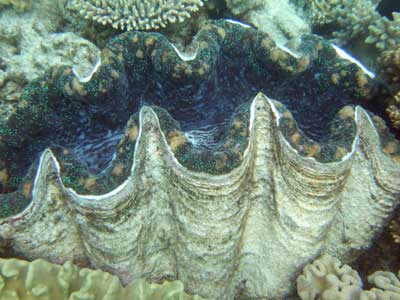 |
Diverse coral reef community on the Great Barrier Reef (Heron Island). Corals are symbiotic associations between an animal (coral polyp) and photosynthetic algae (zooxanthellae) inside the polyp. |
Giant Clam (Tridacna gigas) in the Great Barrier Reef. Note algae in mantle (rollover image shows greater detail). |
| Other Examples of Symbiotic Associations | |
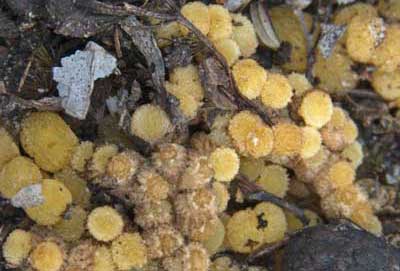 |
 |
Nitrogen fixing symbiotic association of the cycad Macrozamia riedlei. These coralloid roots at the soil surface which contain cyanobacteria that fix nitrogen. Other nitrogen fixing associations include bacteria in nodules of peas (the Fabaceae) and actinomycete nodules in several other plant families. |
The ash bolete (Gyrodon merulioides), which occurs under ash trees in North America (Fraxinus americana), has a symbiotic association with aphids (seen in cross section). See Section 10 for more information. |
1. Plant-Fungal Symbioses
Mycorrhizas are the most important type of symbiotic plant-fungus associations, but there are a wide diversity of other associations between plants and fungi, as illustrated in the diagram below (pdf version). The relationship between mycorrhizas and other types of plant-fungus associations, such as parasitic or endophytic associations, are also shown below.
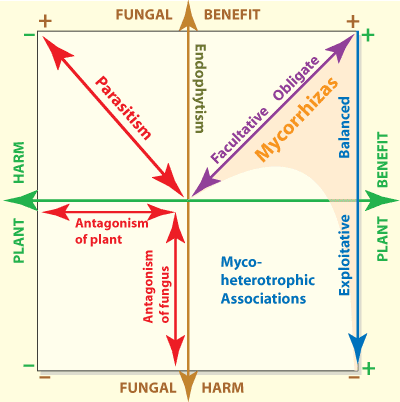 |
This diagram compares types of plant-fungus interactions and each is explained separately below (after Brundrett 2004). Mutualistic associations occupy the mutual benefit (+ +) quadrant in diagrams contrasting the relative benefits (+) or harm (-) to two interacting organisms (Boucher 1985, Lewis 1985). This is a phase plane diagram that describes biological interactions according to a cost-benefit model, where mutualism is an isocline showing both partners are more successful together than they are alone (Boucher 1985, Lewis 1985, Tuomi et al. 2001). |
Explanations
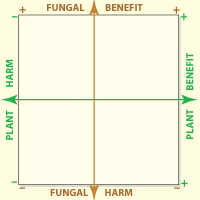 |
The vertical axis is a continuum of fungal harm or benefits. |
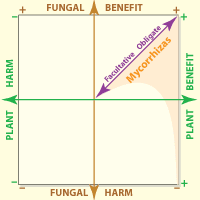 | Fungus benefits are linked to plant benefits in balanced mycorrhizas.
|
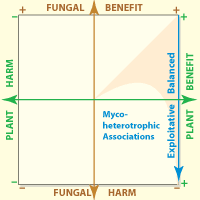 | Exploitative mycorrhizas (myco-heterotrophs) are parallel to the vertical axis - plant benefit occurs at expense of fungi. |
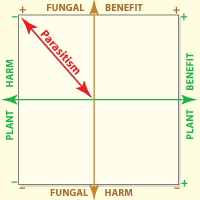 | Parasitic plant-fungal associations are those where fungal benefits are linked to plant harm. |
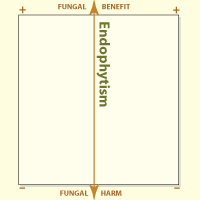 |
Endophytic plant-fungus associations (no plant harm or benefit). |
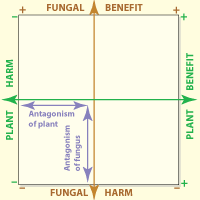 | Other categories of plant-fungus interactions include antagonism of fungi by plants or plants by fungi (causing harm to another organism without gaining direct benefits). |
D. Definition of Mycorrhizas
The name mycorrhizas, which literally means fungus-root, was invented by Frank (1885) for non-pathogenic symbiotic associations between roots and fungi. A revised definition that includes non-mutualistic mycorrhizas and excludes other plant-fungus associations is provided below (Brundrett 2004). You should refer to review articles and books on mycorrhizas for further information about these associations.
|
| Key characteristics of mycorrhizas | ||
| Fungus | Symbiosis | Plant |
| Soil inhabitant1 | Intimate contact at interface for nutrient transfer2 | Control of association5 |
| Plant inhabitant1 | Essential for one or both partners3 | Specialised organ6 |
| Specialised hyphae1 | Synchronised development4 | Root or stem6 |
Notes
- The structure and development of mycorrhizal fungus hyphae is substantially altered in the presence of roots of host plants. These root-borne hyphae are distinct from hyphae which are specialised for growth in soil.
- All mycorrhizas have intimate contact between hyphae and plant cells in an interface where nutrient exchange occurs.
- The primary role of mycorrhizas is the transfer of mineral nutrients from fungus to plant. In most cases there also is substantial transfer of metabolites from the plant to fungus.
- Mycorrhizas require synchronised plant-fungus development, since hyphae only colonise young roots (except orchid mycorrhizas and exploitative VAM).
- Plants control the intensity of mycorrhizas by root growth, digestion of old interface hyphae in plant cells (AM, orchid), or altered root system form (ECM).
- Roots evolved as habitats for mycorrhizal fungi (see Section 2). Mycorrhizas normally occur in roots, but can be hosted in stems in some cases (e.g. some orchids).
E. Categories of Mycorrhizal Associations
Consistent definitions of mycorrhizal associations are required for accurate communication of data. The flowchart below groups similar types of mycorrhizas together using categories regulated by the host and morphotypes caused by different fungi (pdf version). Categories and subcategories are defined in the subsequent table.
| Association | Categories | Morphotypes |
Arbuscular Mycorrhizal Associations |
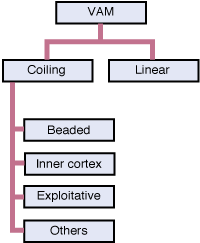 |
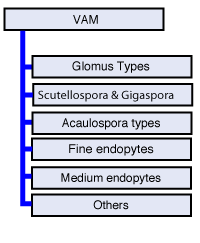 |
Ectomycorrhizal Associations |
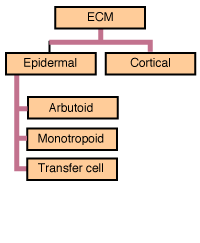 |
 |
| Definitions | See Table below | See ECM and VAM sections |
Hierarchical Classification Scheme for Mycorrhizal Associations (Brundrett 2004)
| No. | Category | Definition | Hosts | Fungi |
| 1 | Arbuscular mycorrhizas | Associations formed by Glomeromycotan fungi in plants that usually have arbuscules and often have vesicles (also known as vesicular-arbuscular mycorrhizas, AM, VAM). | Plants | Glomeromycota (see Section 4) |
| 1.1 | Linear VAM | Associations that spread predominantly by longitudinal intercellular hyphae in roots (formerly known as Arum series VAM). | Plants | As above |
| 1.2 | Coiling VAM | Associations that spread predominantly by intracellular hyphal coils within roots (formerly known as Paris series VAM). | Plants | As above |
| 1.2.1 | Beaded VAM | Coiling VAM in roots, where interrupted root growth results in short segments divided by constrictions. | Woody plants | As above |
| 1.2.2 | Inner cortex VAM | Coiling VAM with arbuscules in one layer of cells of the root inner cortex. | Plants | As above |
| 1.2.3 | Exploitative VAM | Coiling VAM of myco-heterotrophic plants, usually without arbuscules. | Achlorophyllous plants | As above |
| 2 | Ecto-mycorrhiza (ECM) | Associations with a hyphal mantle enclosing short lateral roots and a Hartig net of labyrinthine hyphae that penetrate between root cells. | hosts | Higher fungi (asco-, basidio- and zygo- mycetes) - see Section 9 |
| 2.1 | Cortical | Hartig net hyphae penetrate between multiple cortex cell layers of short roots | Most are gymnosperm trees | As above |
| 2.2 | Epidermal | Hartig net fungal hyphae are confined to epidermal cells of short roots | Angiosperms (most are trees) | As above |
| 2.2.1 | Transfer cell | Epidermal Hartig net with transfer cells (plant cells with wall ingrowths) | Pisonia (Nyctaginaceae). See Peterson et al. 2004 for others | Tomentella spp. in Pisonia (Chambers et al. 2005) |
| 2.2.2 | Monotropoid | Exploitative epidermal ECM of myco-heterotrophic plants in the Ericaceae where individual hyphae penetrate epidermal cells. | Ericaceae (Monotropa, Pterospora, Sarcodes) | Basidiomycetes |
| 2.2.3 | Arbutoid | ECM of autotrophic plants in in the Ericaceae where multiple hyphae penetrate epidermal Hartig net cells. | Ericaceae (part only) | Basidiomycetes |
| 3 | Orchid | Associations where coils of hyphae (pelotons) penetrate within cells in the plant family Orchidaceae. | hosts | Most are basidiomycetes in Rhizoctonia alliance (listed below). |
| 3.1 | Orchid Root | Associations within a root cortex. | Orchidaceae | As above |
| 3.2 | Orchid Stem | Associations within a stem or rhizome. | Orchidaceae | As above |
| 3.3 | Exploitative Orchids | Associations of myco-heterotrophic orchids. | Orchidaceae (fully or partially achlorophyllous) | Orchid, ectomycorrhizal, or saprophytic fungi |
| 4 | Ericoid | Coils of hyphae within very thin roots (hair roots) of the Ericaceae. | Ericaceae (most genera) | Most are Ascomycetes (listed below) |
| 5 | Sub- epidermal | Hyphae in cavities under epidermal cells, only known from an Australian monocot genus. | Thysanotus spp. (Laxmaniaceae) | Unknown |
F. Morphology of Mycorrhizal Associations
The mycorrhizal association types defined in the table above are briefly described and illustrated below. More information on arbuscular mycorrhizas and ectomycorrhizas are provided in dedicated Sections of this site.
1. Arbuscular Mycorrhizas
Arbuscular mycorrhizas (Vesicular-Arbuscular Mycorrhizas, VAM or AM) are associations where Glomeromycete fungi produce arbuscules, hyphae, and vesicles within root cortex cells. These associations are defined by the presence of arbuscules. Fungi in roots spread by linear hyphae or coiled hyphae. VAM associations are described in detail in Section 4.
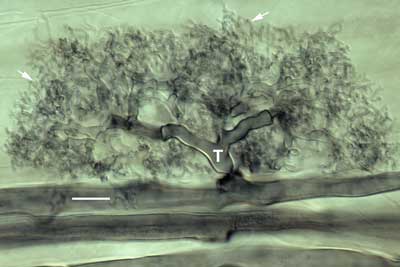 |
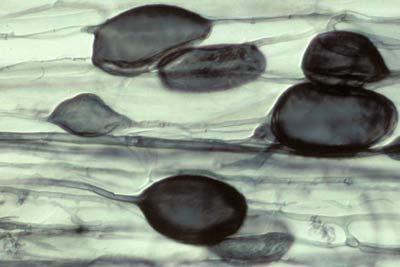 |
Arbuscule of a Glomus species in a root cortex cell. More information. |
Vesicles of a Glomus species in a root cortex. |
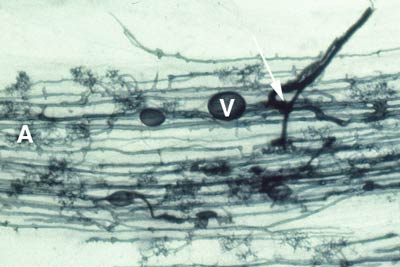 |
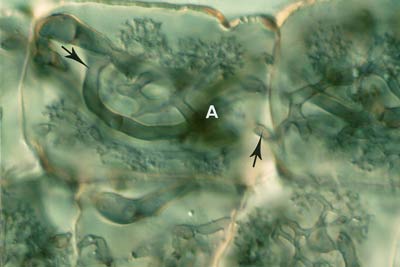 |
1.1. Linear association in root of Allium porrum with arbuscules (A) and vesicles (B) on longitudinal hyphae near entry point (arrow). More information. |
1.2. Coiling association with arbuscules (A) on coiling hyphae (arrow) in a root of Erythronium americanum. More information. |
 |
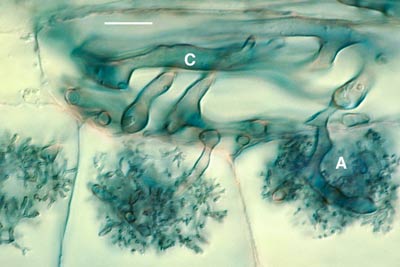 |
1.2.1. Beaded roots (arrows) of Sugar Maple (Acer saccharum) - a VAM host. More information |
1.2.2. Coiling association with arbuscules (A) only in the inner cortex layer of Asarum canadense roots. |
1.2.3. Myco-heterotrophic "Arbuscular" Mycorrhizas
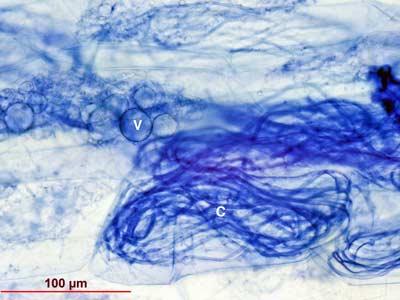 |
1.2.3. Coils of hyphae in the rhizome of Psilotum nudum a whisk fern. This is a type of VAM association without arbuscules from a young sporophyte with green shoots that is not fully myco-heterotrophic. See Section 2 for more information on mycorrhizas of primitive plants. Cleared and stained rhizome
|
2. Ectomycorrhizas
Ectomycorrhizas (ECM) are associations where fungi form a mantle around roots and a Hartig net between root cells. These associations are defined by Hartig net hyphae which grow around cells in the epidermis or cortex of short swollen lateral roots. ECM associations are described in Section 4. The former category of ECM is a morphotype (defined by fungi not hosts). Characteristics of this ECM morphotype are summarised by Yu et al. (2001).
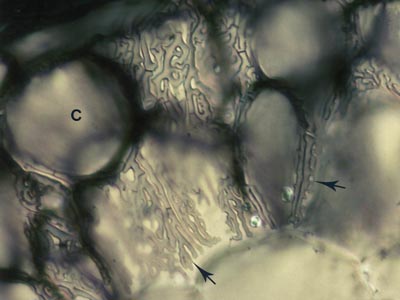 |
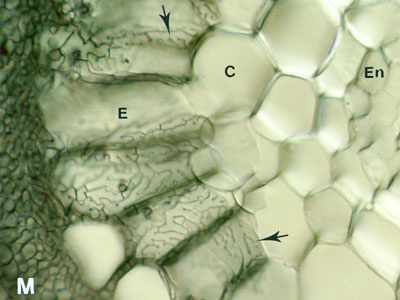 |
2.1. Cortical Hartig net of Pinus ECM root. Highly magnified view of cleared and stained section
|
2.2. Epidermal Hartig net of Populus ECM. Highly magnified view of cleared and stained section
|
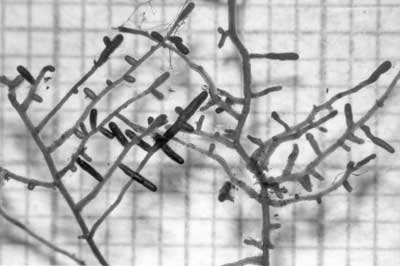 |
Betula root system showing thicker branched or unbranched ECM roots borne on thinner lateral roots. ECM root systems are described in Section 5. Magnified view of ECM root system |
2.2.2 Monotropoid
Monotropoid mycorrhizas are ECM associations of a few genera of myco-heterotrophic plants in the Ericaceae. These associations are characterised by limited hyphal penetration into epidermal cells. Information on structure of associations and the identity of mycorrhizal fungi in Monotropa, Pterospora, Sarcodes, etc. is provided by Robertson & Robertson (1982), Castellano & Trappe (1985) and Bidartondo et al. (2000).
2.2.3 Arbutoid Mycorrhizas
Arbutoid mycorrhizal associations are variants of ECM found in certain plants in the Ericaceae characterised by hyphal coils in epidermal cells. These mycorrhizal roots are described by Largent et al. (1980), Molina & Trappe (1982) and Massicotte et al. (1998, 2005a). Gaultheria and Kalmia have ericoid mycorrhizas as well as arbutoid associations (Massicotte et al. 2005b).
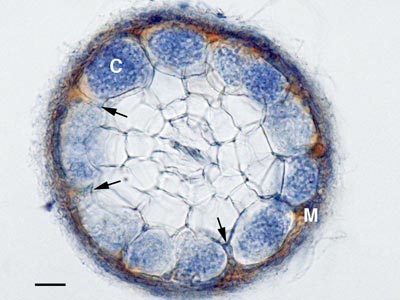 |
2.2.3. Arbutus unedo root with Hartig net (arrows), coils (C) and mantle (M) of stained or unstained hyphae. Highly magnified views of sectioned and cleared roots |
3. Orchid Mycorrhizas
Orchid mycorrhizas consist of coils of hyphae within roots or stems of orchidaceous plants. Details of Orchid mycorrhizal associations are not provided here, but Australian Orchids found to have mycorrhizas are listed.
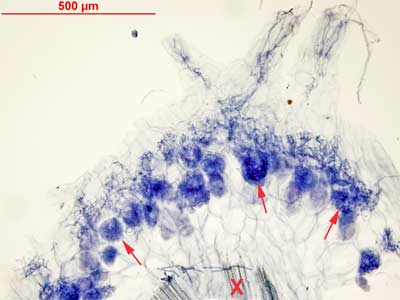 |
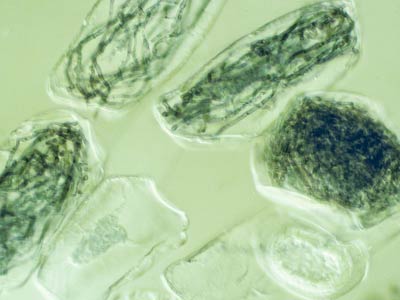 | |
3.2. Orchid mycorrhizas with hyphae in trichomes and hyphal coils in stem of Pterostylis vittata
|
3.1. Hyphal coils from orchid mycorrhizas in Epipactis helleborine root.
|
4. Ericoid Mycorrhizas
Ericoid mycorrhizas have hyphal coils in outer cells of the narrow "hair roots" of plants in the family Ericaceae. These associations are not described in detail here, but Australian plants with these mycorrhizas are listed.
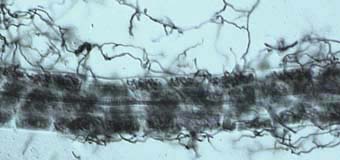 |
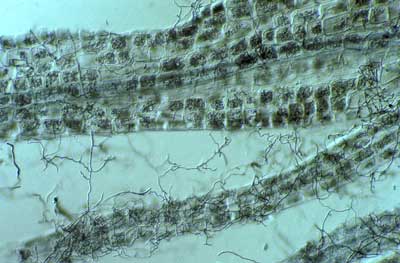 |
Ericoid mycorrhizas with hyphal coils in hair roots of Leucopogon verticillatus
|
5. Subepidermal Association of Thysanotus
The Australian lilies in the genus Thysanotus (Laxmaniaceae) have unique mycorrhizas where fungus hyphae grow in a cavity under epidermal cells. Other members of this family have VAM or have NM roots (Section 8).
|
 |
G. Host Plants
Comprehensive lists of Australian mycorrhizal plants, as well as plant families which are ECM hosts, or have NM roots are presented in Sections 5, 6 and 8 of this site. A summary of mycorrhizal associations in flowering and primitive plants are also provided in Section 2.
Field surveys have found that plants with mycorrhizal associations predominate in most natural ecosystems, as summarised the in table below.
| Association | Occurrence |
| Vesicular Arbuscular Mycorrhizal (VAM) Plants |
|
| Ectomycorrhizal (ECM) Plants See Section 5 |
|
| Nonmycorrhizal (NM) Plants See Section 6 |
|
|
Data are from Brundrett (1991) |
|
H. Mycorrhizal Fungi
Members of the fungus kingdom obtain nutrition from many sources, including decomposition of organic substrates, predation and parasitism, and involvement in mutualistic associations (Christensen 1989, Kendrick 1992). Mycorrhizal fungi are a major component of the soil microflora in many ecosystems, but usually have limited saprophytic abilities (Tanesaka et al. 1993, Hobbie et al. 2001). They are considered to have many important roles in natural and managed ecosystems as explained in Section 7. These fungi are introduced in the table below.
| Mycorrhiza | Phylum | Families | Anamorphs | Teliomorphs | References |
| Arbuscular | Glomeromycota | Glomaceae, Acaulosporacae, etc. | Glomus, Scutellospora, Acaulospora, etc. | none | Listed in Section 4 |
| Ecto- mycorrhiza (ECM) | Basidiomycota, Ascomycota, Zygomycota | Many families including Amanitaceae, Cortinariaceae, Boletaceae, etc. | Most ECM fungi lack anamorphs, but Cenococcum is one example | Many genera including Amanita, Cortinarius, Russula, etc. | Listed in Section 9 |
| Monotropoid ECM | Basidiomycota | Russulaceae, etc. | NA | Russula, Tricholoma, Rhizopogon, etc. | Bidartondo et al. 2000, Bidartondo & Bruns 2001, 2002, Leake et al. 2004 |
| Orchid: not myco- heterotrophic |
Basidiomycota (Ascomycete) | Ceratobasidiaceae, Tulasnellacea, Sebacinaceae (related to Chanterellaceae?) (also many others are reported) | Sterile hyphae: Rhizoctonia alliance: Epulorhiza, Ceratorhiza, Tulasnella, etc. as well as Fusarium, etc. | Ceratobasidium, Thanatophorus, Sebacina, etc. | Zelmer et al. 1996, Rasmussen 2002, McCormick et al. 2004, Bayman & Otero 2006, Dearnaley 2007, Taylor & McCormick 2007 |
| Orchid: myco- heterotrophic |
Basidiomycota | Russulaceae, Telephoraceae, etc. | NA | unrelated clades of ECM, orchid and saprophytic fungi | See lists by Batty et al. 2002, Bidartondo et al. 2004, Dearnaley 2007 |
| Ericoid | Ascomycota (Basidiomycota) | Helotiaceae (Sebacinaceae) | NA | Hymenoscyphus, Rhizoscyphus, (Sebacina) | Allen et al. 2003, Berch et al. 2003, Bougoure & Cairney 2005, Selosse et al. 2007 |
I. Terminology
- Symbiosis
- Refers to intimate associations between two or more different living organisms. Only a broad definition of symbiosis - living together of two or more organisms includes all types mycorrhizal associations (Lewis, 1985; Smith & Read, 1997).
- Mutualism
- A category of symbiotic associations where both partners benefit (see Fig. 1 below). Mycorrhizas of myco-heterotrophic plants are not mutualistic as the fungus is being
- Mycorrhiza, Mycorrhizas, Mycorrhizal
- These were defined by Frank (1885) as symbiotic associations between fungi and roots that are not pathogenic (i.e. intimate root-fungus associations without disease symptoms). Frank named these associations mycorrhizas which means fungus-root (they were formerly called mycorrhizae). A comprehensive definition of mycorrhizas is provided above.
- Myco-heterotrophic mycorrhizas
- Non-mutualistic mycorrhizal associations where plants are parasitic on fungi (see Leake 1994). These plants are sometimes referred to as saprotrophic, cheating, myco-parasitic, etc. However, these should be referred to as myco-heterotrophic (fungus feeding) or exploitative associations.
- Host Plant
- A plant containing a fungus of any type.
- Mycorrhizal fungi
- These can be called a symbiont, associate, mycobiont, inhabitant, etc. , but it is usually sufficient to call them fungi. Mycorrhizal fungi should not be called endophytes to avoid confusion with another major category of plant inhabiting fungi.
- Colonisation
- neutral term ‘colonisation’ is preferential to infection (implying disease) when describing mycorrhizal fungus activity and the resulting fungal structures can be defined as colonies.
- Inoculum
- propagules of fungi capable of dispersing or initiating contact with plants.
- Vascular plants
- "Higher plants" with conducting elements for water and nutrients, differentiated leaves and roots, with a dominant sporophyte.
- Roots
- Plant organ responsible for nutrient uptake, mechanical support, storage, etc. that are usually subterranean.
- Fungi
- Members of the fungus kingdom are eukaryotic, heterotrophic organisms with a tubular body that reproduce by spores.
- Mineral nutrients
- The basic form of substances required for life (N, P, K, etc. excluding gases).
- Photosynthesis
- Solar energy capture by plants and conversion into organic carbon.
Version 2 © Mark Brundrett 2008
